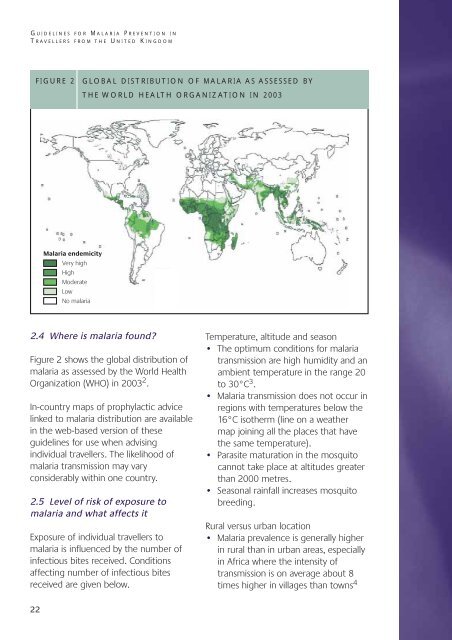Guidelines for malaria prevention in travellers from the United ...
Guidelines for malaria prevention in travellers from the United ...
Guidelines for malaria prevention in travellers from the United ...
Create successful ePaper yourself
Turn your PDF publications into a flip-book with our unique Google optimized e-Paper software.
G UIDELINES FOR M ALARIA P REVENTION IN<br />
T RAVELLERS FROM THE U NITED K INGDOM<br />
2.4 Where is <strong>malaria</strong> found?<br />
Figure 2 shows <strong>the</strong> global distribution of<br />
<strong>malaria</strong> as assessed by <strong>the</strong> World Health<br />
Organization (WHO) <strong>in</strong> 2003 2 .<br />
In-country maps of prophylactic advice<br />
l<strong>in</strong>ked to <strong>malaria</strong> distribution are available<br />
<strong>in</strong> <strong>the</strong> web-based version of <strong>the</strong>se<br />
guidel<strong>in</strong>es <strong>for</strong> use when advis<strong>in</strong>g<br />
<strong>in</strong>dividual <strong>travellers</strong>. The likelihood of<br />
<strong>malaria</strong> transmission may vary<br />
considerably with<strong>in</strong> one country.<br />
2.5 Level of risk of exposure to<br />
<strong>malaria</strong> and what affects it<br />
Exposure of <strong>in</strong>dividual <strong>travellers</strong> to<br />
<strong>malaria</strong> is <strong>in</strong>fluenced by <strong>the</strong> number of<br />
<strong>in</strong>fectious bites received. Conditions<br />
affect<strong>in</strong>g number of <strong>in</strong>fectious bites<br />
received are given below.<br />
22<br />
FIGURE 2<br />
Malaria endemicity<br />
Very high<br />
High<br />
Moderate<br />
Low<br />
No <strong>malaria</strong><br />
GLOBAL DISTRIBUTION OF MALARIA AS ASSESSED BY<br />
THE WORLD HEALTH ORGANIZATION IN 2003<br />
Temperature, altitude and season<br />
• The optimum conditions <strong>for</strong> <strong>malaria</strong><br />
transmission are high humidity and an<br />
ambient temperature <strong>in</strong> <strong>the</strong> range 20<br />
to 30°C 3 .<br />
• Malaria transmission does not occur <strong>in</strong><br />
regions with temperatures below <strong>the</strong><br />
16°C iso<strong>the</strong>rm (l<strong>in</strong>e on a wea<strong>the</strong>r<br />
map jo<strong>in</strong><strong>in</strong>g all <strong>the</strong> places that have<br />
<strong>the</strong> same temperature).<br />
• Parasite maturation <strong>in</strong> <strong>the</strong> mosquito<br />
cannot take place at altitudes greater<br />
than 2000 metres.<br />
• Seasonal ra<strong>in</strong>fall <strong>in</strong>creases mosquito<br />
breed<strong>in</strong>g.<br />
Rural versus urban location<br />
• Malaria prevalence is generally higher<br />
<strong>in</strong> rural than <strong>in</strong> urban areas, especially<br />
<strong>in</strong> Africa where <strong>the</strong> <strong>in</strong>tensity of<br />
transmission is on average about 8<br />
times higher <strong>in</strong> villages than towns 4


